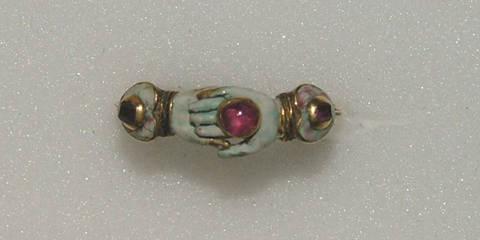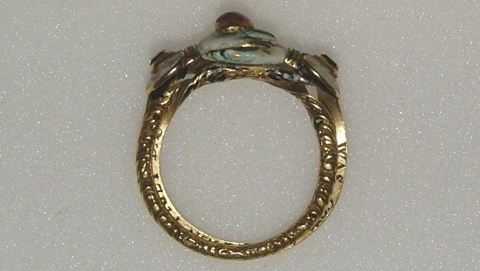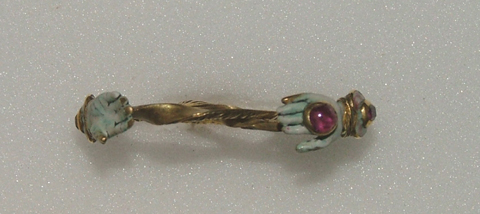Finger Ring Collection
Browse Collection
28 of 436

Click to hide image

Click to hide image
Gimmel ring
Germany
17th century
Gold gimmel ring, the bezel in the shape of clasped hands enamelled white, the upper one having a ring set with a cabochon ruby, the hoop chased with scrolls and a white enamelled heart on each shoulder set with a ruby; inscribed WAS GOT ZU SAMEN FIGET DAS SOL DER MENSCH NIT SCHAIDEN translating 'What God has joined together let no man put asunder' (St. Mark, X, v.9)
16.31 mm internal ring diameter; 4.28 g weight
Bought in Paris
Presented by Dr C.D.E. Fortnum in honour of Queen Victoria's Diamond Jubilee, 1897; WA1897.CDEF.F519
The gimmel ring (from the Latin 'gemellus' meaning twins) has a double interlaced hoop and bezel. On the betrothal of the couple, each lover would be given one part of the ring and then on the occasion of the marriage the two parts were linked together. They were particularly popular in Germany in the 16th and 17th centuries although their existence can be traced back to 14th century England. The motif of the clasped hands derives from Roman times when the gesture of clasped right hands (dextrarum iunctio) symbolized marriage. The motif reappeared in the twelfth century. It was popular in both southern and northern Europe.
Scarisbrick and Henig, Finger Rings, 2003, pl. 23.1

|

|
Other Images

Click to hide image

Click to hide image

Click to hide image

|

|

|

.jpg)
